Saving butterflies, moths and our environment
Celebrating our 40th Anniversary!
1982 - 2022
Clouded Yellow & Grayling at Browndown South. On a walk along & near the Gosport coast from Alverstoke to Stokes Bay,Stanley Park,Browndown South & Browndown Field,1030-1710,I recorded 107 butterflies:Clouded Yellow(1 male at Browndown South),Small White(83,including a mating pair),Green-veined White(1 male & 3 females,including a mating pair),Small Copper(1),Common Blue(1 male),Holly Blue(4 males),Red Admiral(3),Comma(1),Speckled Wood(2),Grayling(only 1 at Browndown South),Meadow Brown(2) & Small Heath(4);also Silver Y Moth(1),Migrant Hawker(4) & Common Darter(6). [Posted by David Tinling]
Adonis Blue aberration. I photographed this male Adonis Blue aberration on private land at Cholderton today. Its missing the usual black spots on the underside hindwing. [Posted by Tim Norriss]
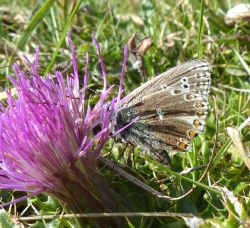 |
| Adonis Blue ab. Photo © Tim Norriss |
Old Winchester Hill. Roy Symonds happily reports from Old Winchester Hill where he finally saw 6 male Adonis Blues, his first sightings this year of this colourful butterfly. All were found at the bottom of car park slope, while around the hill fort a pair of Clouded Yellows were seen. A number of fresh Brimstones were seen, while 5 worse for wear Chalkhill Blues were still flying. Other species recorded were: Small White, Meadow Brown, Small Heath, Gatekeeper, Small Tortoiseshell, Red Admiral and Common Blue. [Posted by Richard Symonds]
Old Winchester Hill wanderings...... Thanks to a number of recent news items I took on the steeps of Old Winchester Hill late morning and afternoon today. A lovely bright Silver-spotted skipper fortuitously arrested my hectic descent. Soon the first Chalk-hill blue of my year was seen but most specimens were well past their summer sell-by date. Encouraged by earlier reported sightings, I was on the look-out for the spectacular Adonis blue which I had never seen before. So I wandered lower and lower and towards the bottom of the hill on a rather soft pat of recent sheep dung sat Adonis blue! Like a bus, not one but two! Perhaps not quite living-up to their name these two lads were tucking-in heartily, fighting-off flies and climbing over themselves to get to the juicy bits! So that was nice! A fresh Brimstone with more agreeable dining habit also obliged the camera. A great day out and really nice to bump into a fellow Hantsiow-butterflies contributor. [Posted by Francis Plowman]
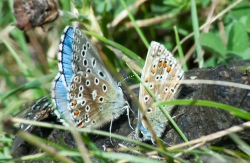 |  | 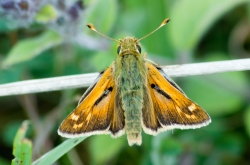 |
| Adonis blue on poo! Photo © Francis Plowman | Fresh male Brimstone Photo © Francis Plowman | Silver-spotted skipper Photo © Francis Plowman |
Brown Hairstreaks At Noar Hill. Went to Noar Hill this morning in search of Brown Hairstreaks. There were several people there doing the same thing and we were rewarded with the sight of 2 females egg laying near 'The Triangle'. Also saw a large number of Brimstones nectaring in the furthest Chalk Pit. [Posted by Francis Kinsella]
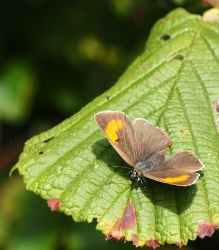 | 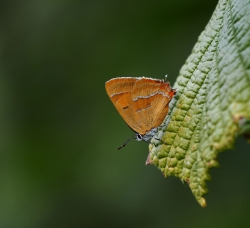 |
| Photo © Francis Kinsella | Photo © Francis Kinsella |
Streaking at Noar Hill. I spent a few hours either side of midday at Noar hill today searching for Brown Hairstreaks, along with a few others enjoying the late season warmth . It wasn't long before two egg laden females were located in a short stretch of South facing blackthorn where they were observed crawling around finding suitable places to lay their eggs. I observed perhaps half a dozen ova being laid, including two that were laid adjacent one that was already in position making a trio. It was difficult to estimate how many different individuals were actually present but I saw six myself and from chatting to the other people present I would say that at least a dozen different females were seen today - no males unlike yesterday which is interesting - making it a very positive year for this enigmatic Hampshire butterfly. [Posted by Mark Tutton]
Beacon Hill NNR. With the Magdellan Hill Down New Members Day and Conservation in the forefront of everybody's mind brings me in nicely to my walk around Beacon Hill today. My target species was the Silver-Spotted Skipper but alas I'm sad to say I never found one. Its been in decline at this site for several years now and its breeding areas, where I used to see it in very good numbers is like an area of Elephant grass. I did find an area where they have cordoned off with Electric fencing and here there has been a lot of conservation work, where the sward is very short ideal for this species. I saw a lot of rabbit droppings and sheep in this area tiding up. I looked over the fence for up to an hour but I still never got a glimpse of one. Highlights of the walk around the site were many Red Admirals, Chalkhill Blue, Small Heath, and Brown Argus. My last field trip is next week so do come along, especially all the new members! Lets make it a good one.... [Posted by Ashley Whitlock]
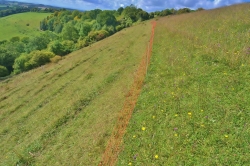 | 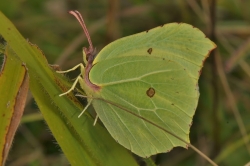 | 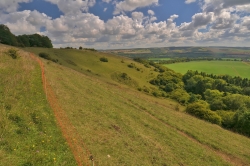 |
| Beacon Hill with short cropped grasses Photo © Ashley Whitlock | Brimstone Photo © Ashley Whitlock | Beacon Hill Photo © Ashley Whitlock |
Grayling at Browndown North. In warm but very weak sunshine from 1000 to 1535 I walked along and near the Gosport coast from Haslar to Gilkicker,Alverstoke village and Browndown North,where the sunshine soon disappeared,but before it clouded over I recorded 50 butterflies:Small White(19),Green-veined White(2 very fresh females),Common Blue(9 males),Holly Blue(6 males),Red Admiral(1),Grayling(7 at Browndown North including a female photographed with her wings wide open as she opened and closed them to reject a courting male),Meadow Brown(3) & Small Heath(3);also Migrant Hawker(4) 7 Common Darter(10). [Posted by David Tinling]
Chalton Down. Roy Symonds reports from Chalton Down, Old Idsworth where the Chakhill Blue is still just hanging on with 5 individuals seen. Plenty of Common Blues were flying, but single numbers of Meadow Brown, Gatekeeper, Speckled Wood, Small Heath and a single Brown Argus were recorded. [Posted by Richard Symonds]
New Members' Day. A great time was had by all at the annual New Members' Day, where a series of presentations is followed by a walk at Magdalen Hill Down. Excellent talks from Mike Wall (intro), Penny Jeffreys (reserves), Dan Hoare (BC and the Dukes on the Edge project), Clive Wood (information and volunteering) and Tim Norriss (recording). Dan's talk was, I felt, particularly inspiring and reminded me why I joined BC in the first place; first-class conservation is taking place on our doorstep, although we may not always realise it! Despite the largely-overcast conditions during the walk on the down, we managed to locate a Clouded Yellow, a Chalk Hill Blue egg, the remains of a Small Blue egg, as well as several other butterfly and moth species. [Posted by Pete Eeles]
 |  | 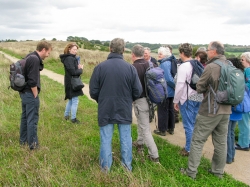 |
| Andy Barker introducing MHD Photo © Pete Eeles | MHD has Excellent Signage! Photo © Pete Eeles | Penny and Dan in action! Photo © Pete Eeles |
Butterflies at home. Ive had two Red Admirals permanently sat on my Buddleia Bush in the front garden all, week, despite some pretty appalling weather conditions. They must have got drunk on the nectar,and today I've had one in the back garden with a Comma as well, with many Small Whites. The Whites this year are no where near as numerous as this time last year.I thought I would share with the readers just how beautiful these butterflies are in close up the marvellous mosaic pattern on the underneath of the hind wing...marvellous. [Posted by Ashley Whitlock]
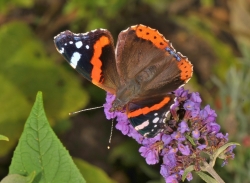 |  | 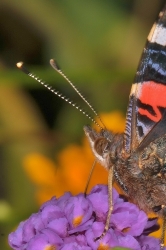 |
| Red Admiral on Buddleia Photo © Ashley Whitlock | Red Admiral Photo © Ashley Whitlock | Red Admiral Photo © Ashley Whitlock |
Small Ranunculus breeding in Hampshire. After attending New Members Day this morning and meeting lots of interesting new(ish) members of the Branch Lynn and I got lost near Micheldever and stopping by the road to get our bearings found several larvae of Small Ranunculus on prickly lettuce. I have found them before in Surrey several years running when I worked there but this is the first time larvae have been found in Hampshire - so a good result from going the wrong way! There have been 34 records of adults in the county all since 2009. It has not yet been recorded on the Isle of Wight. http://www.hantsmoths.org.uk/species/2165.php [Posted by Tim Norriss]
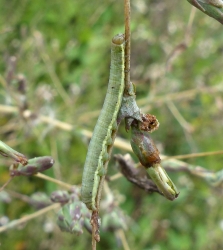 | 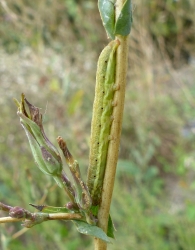 |
| Small Ranunculus larva Photo © Tim Norriss | Small Ranunculus larva Photo © Tim Norriss |
photos taken this year. Two photos of female common blue taken today at alver valley and ringlet at peel common last month [Posted by Mike gregory]
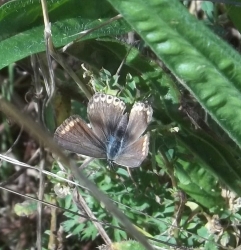 |  | 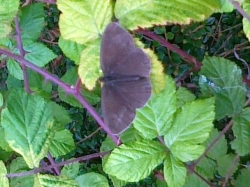 |
| Photo © Mike gregory | Photo © Mike gregory | Photo © Mike gregory |
Male Brown Hairstreaks. I was surprised to find 4 male Brown Hairstreaks in the cool windy overcast conditions today at Noar Hill. [Posted by nick lawrence]
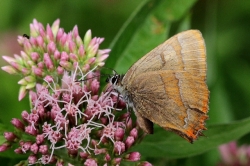 | 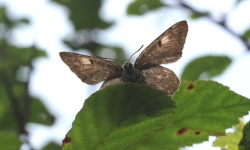 |
| Photo © nick lawrence | Photo © nick lawrence |
British Wildlife Magazine. Seeing Lyns note about "a polluted countryside?" Published in British Wildlife magazine beat me to it. In the latest issue there is also a great article about Glanville Fritillaries by Robin Curtis and their precarious existence - going down to only 30 larval webs in very recent times. I have subscribed to this magazine for 10+ years and is an excellent, value for money, read for anyone interested in all aspects of British wildlife - and there are frequent very well informed items about Butterflies and Moths. I can thoroughly recommend it - see http://www.britishwildlife.com
Not a plug as I have no connection with the publishers. [Posted by Mark tutton]
A polluted countryside?. Neonicotinoids
Readers of British Wildlife August 2014 issue will have read of the widespread damage being caused to many species and whole ecosystems. The information that the article highlighted cane from an online summary issued by the Task Force on Systemic Pesticides - see http://www.tfsp.info
The Task Force says that " Neonics impact a;; species that chew a plant, sip its sap, drink ts nectar,eat its pollen or fruit and these impacts cascade through an ecosystem weakening its stability.
A study in Holland linked the decline in insectivorous bird populations with the introduction of the neonicotinoid pesticide imidacioprid. There is a problem that the dressing of seeds is leading to a build-up of this chemical in the soil which then causes it to be present in other plantswhich grow there subsequently.
And it is not just neonics, the article goes onto draw attention to problems caused by the growing use of glyphosate. Promoted as being harmless the herbicide has been found to accumulate in human breast milk( upto 1,600 times the level permitted in EU drinking water. Worse still in El Salvador and Sri Lanka it has been linked with a mysterious kidney disease killing agricultural workers.
The same section of British Wildlife 'Conservation News' reports that an analysis of 94 existing studies of organic farming and biodiversity has concluded that organic farming methods result in an average increase in biodiversity of 34% compared with non-organic methods. It refers to the downside to the organic cultivation of some crops as the conversion process has resulted in the loss of permanent grassland and other negative effects.
I was pleased that a reputable magazine highlights these threats. For years we have been aware of declines in butterfly and moth populations. Regarding moths, people remember that night driving used to produce a snowstorm of moths in front of the car. Who has seen that in recent years? The loss of insects affects birds without a doubt and again the loss of farmland birds has been greatly publicised. It really is time for change. Change in what we eat and how it is produced. Sustainability is the key. The protection of our soil, water and wildlife being important elements in the process of producing food. [Posted by Lynn Fomison]
Brown Hairstreak at Noar Hill. Female Brown Hairstreak at Noar Hill this morning. Showing well in between egg-laying but sadly a tragic end when caught by a spider and neatly parceled up. [Posted by Pauline Richards]
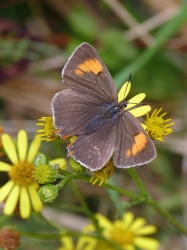 | 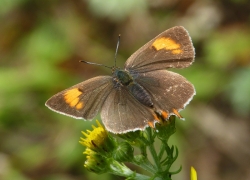 |  |
| Female BH resting after oviposting Photo © Pauline Richards | Female BH Photo © Pauline Richards | Caught by spider Photo © Pauline Richards |
Painted Lady & 3 Clouded Yellows on the Gosport coast.. Painted Lady at Fort Gilkicker & 3 Clouded Yellows(2 males & a female)feeding on Prickly Sow-thistle at the western end of the Haslar sea wall on the Gosport coast. [Posted by David Tinling]
Old Winchester Hill. I visited all the major slopes today on what can be only described as pretty cool when the sun wasn't shining, hardly butterfly observation weather. The Silver-Spotted Skipper is having a rough time 1. The weather is against it, the major breeding areas seem to be quite overgrown, and this probably is one of the major reasons for it being rather late emerging at this site. I managed to see (4) on the Hill Fort slope, where I normally see upwards of 20-30 in a good season, I'm just hoping there are more to emerge, as this could be one tragic year....On the other side of the coin I saw (12) Adonis Blues many males on the Hill Fort side and some on the car-park slope, where there was a lovely female ovi-positing on Horse-Shoe Vetch. Other highlights were (2) Clouded Yellows, (16) or more Brown Argus, many Common Blues, and there are still hundreds of Chalkhill Blues on all the major slopes, in many kinds of condition. (2) Small Skipper, still hanging on Small Heath are building up their number nicely. [Posted by Ashley Whitlock]
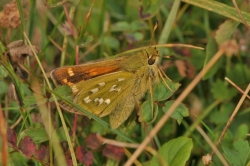 | 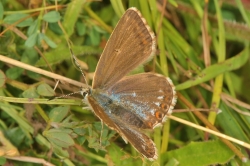 | 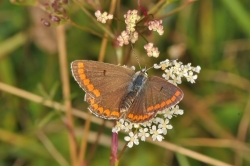 |
| Female Silver-Spotted Skipper Photo © Ashley Whitlock | Female Adonis Blue Photo © Ashley Whitlock | Brown Argus Photo © Ashley Whitlock |
Weekend doings. On saturday the weather looked quite bright so I decided to try and track down the elusive Brown Hairstreaks at Noar Hill There were nice spells of sunshine and I was hopeful that I could find a female in one of the areas of suckering blackthorn where i have found eggs previously. After a couple of hours I was beginning to loose hope and reverted to egg searching finding half a dozen or so - proving that they have been around and active. After spending half hour with fellow enthusiasts in the triangle area I bade them farewell to explore an area on the North Track. As I left the reserve I noticed what I thought was a Gatekeeper, but when it perched and opened its wings a pretty fresh female Brown Hairstreak was revealed. I managed to get a couple of shots before it disappeared up and over the hedgerow not to be seen again. I saw eleven species in all including a few late Silver Washed Fritillaries and a supercharged Clouded Yellow.
The forecast for sunday was good and I had visitors coming so I paid a quick visit to Portsdown Hill to see how the Chalk Hill Blues were doing in front of Fort Widley. It was a bit late in the season to pay my first visit but I was pleased to see half a dozen males. The area is a profusion of flowers - almost Alpine meadow like - which is a credit to the grazing regime. If they can get some areas with slightly shorter sward I am sure the CHB colony will explode. [Posted by Mark Tutton]
 | 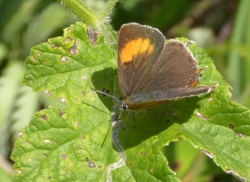 | 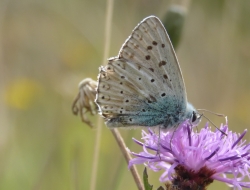 |
| Brown Hairstreak egg Photo © Mark Tutton | Female Brown Hairstreak Photo © Mark Tutton | Chalk Hill Blue Photo © Mark Tutton |
Chalton Down Clouded Yellows. After a disappointing visit to Old Winchester Hill, Roy Symonds reports he visit the more sheltered Chalton Down, where the temperature was a few degrees higher. A pair of Clouded Yellows were seen, which seem to be the resident pair in the area and close photos were taken. A total of 45 Common Blues were seen totally outnumbering the 3 Chalkhill Blues present which now seem to have finished for the year.Around a dozen Meadow Browns were seen and also a single Gatekeeper. Other species recorded were Brimstone, Small White and Green Veined White. [Posted by Richard Symonds]
Old Winchester Hill. Roy Symonds reports he visited Old Winchester Hill in the late morning. On arrival the weather was overcast and the temperature only 15 degrees. On a disappointing visit only 5 species were seen with the exception of Meadow Brown all in single figures. Small White, Meadow Brown, Gatekeeper, Chalkhill Blue and Small Tortoiseshell were seen. [Posted by Richard Symonds]
Gosport & Widley wanderings....... The ex-car graveyard at the far end of Frater Lane, Gosport was revisited today after some 43 years or more. Now a grassy meadow enclosed on three sides by tall deciduous trees generously laced with budleia, holly, ivy and brambles galore. Here a fresh and cooperative Comma dried its magnificent wings; a slightly elderly cousin posed to display its signature punctuation mark. It gained my attention initially by alighting upon my shoulder! Holly blues were defending their patch with vigour but following its exertion one male accepted the camera's intrusion without demur. Five other species provided photographic opportunities. The Widley Walk (Portsdown Hill) in the afternoon noted 20 Common blue of both sexes but the Chalk hill blue remains conspicuous by its absence this year. I had hoped also to find last week's sighted Clouded yellow but alas. [Posted by Francis Plowman]
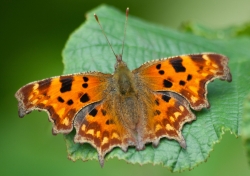 |  | 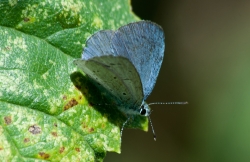 |
| Fresh Comma drying out at Frater Photo © Francis Plowman | "Nice comma, Comma!" Field at Frater, Gosport Photo © Francis Plowman | Holly blue male also at Frater Photo © Francis Plowman |
Adonis Blues On Old Winchester Hill. A short visit to the car park slope of Old Winchester Hill, in cool but bright conditions this morning, produced 4 male Adonis Blues. A couple of them were quite faded, however one in particular was in fresh condition, its wings dazzling in the sunshine (photos below). No females were seen. In the same area, other sightings of particular note were one Clouded Yellow and one Silver-spotted Skipper. [Posted by Alan Thornbury]
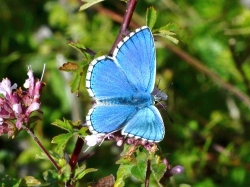 | 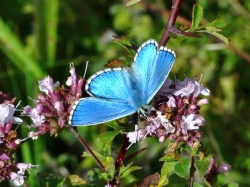 |
| Adonis Blue (Male) Photo © Alan Thornbury | Adonis Blue (Male) Photo © Alan Thornbury |
Members' Area. Those members requesting a new password for the members' area will be pleased to know that the mechanism is now working again. Apologies for any inconvenience caused. [Posted by Pete Eeles]
Annual Butterfly and Moth Report. Apologies to the small number of BC Hants & IoW members that haven't yet received the annual report. They will be posted to you within the next few days. In the meantime members can of course access the Members area on this website to view the report on-line. [Posted by Tim Norriss]
Speckled wood on parade at Yew Hill today!. Some sixteen Speckled wood provided a veritable guard of honour as I trudged under cloudy skies through the fields to the Yew Hill reserve outside Oliver's Battery. Dark and fresh specimens, well camouflaged cousins seeking warmth on straw and wobbly, tatty examples at the end of their lives. Also noted in good number Meadow brown and Common blue both male and female well represented. Holly blue, Green-veined white and Small heath put in welcome appearances despite the lack of sunshine. Well worth a visit but sadly no Brown argus or Chalkhill blue noted today. [Posted by Francis Plowman]
 | 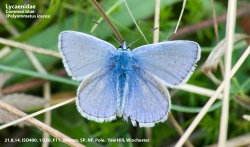 | 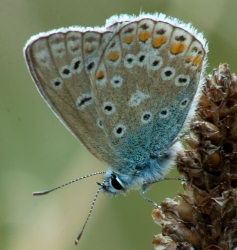 |
| Fresh Speckled wood Photo © Francis Plowman | Common blue at Yew Hill Photo © Francis Plowman | Common blue male at Yew Hill Photo © Francis Plowman |
Idsworth Down. Visited Idsworth Down today in the early part of the morning, making sure I had a short period of sunshine before the clouds gathered. The visit was for the Silver-Spotted Skipper as in 2009 I visited this site and found one/two on the southern slope. I never followed up the sighting the following year, or any time since except this year. As Mark Tutton saw an individual at Chalton Down in 2013 which is next door, I thought I would chance my arm. However I never managed to see one, as I think it may well have been a drifter from nearby Oxenbourne Down, and the individual was a male I remember. Had it been a gravid female maybe it could have laid a few eggs in the many rabbit scrapes, where its food plant grows, as the turf where I saw the individual, is typical Silver-Spotted Skipper terrain and could well have started a small colony. However I was pleased to see the Brown Argus in a new location and the Small Heath seems to be building in numbers, on my travels. [Posted by Ashley Whitlock]
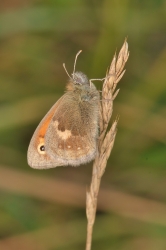 | 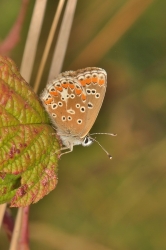 | 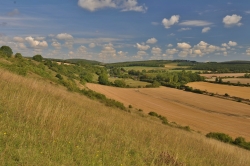 |
| Small Heath Photo © Ashley Whitlock | Brown Argus Photo © Ashley Whitlock | Idsworth Down Photo © Ashley Whitlock |
Chalton Down. Roy Symonds reports visiting Chalton Down (SU736156) after Portsdown Hill. Here the temperature was 17 degrees. Several Meadow Browns were still flying, but only 6 Chalkhill Blues were recorded with 34 Common Blues. Other species seen with only one of each were, Brimstone, Small White, Gatekeeper and Brown Argus. [Posted by Richard Symonds]
Portsdown Hill. Roy Symonds reports visiting Portsdown Hill where the temperature was 16 degrees. On the East end directly above Queen Alexandra Hospital, 8 Common Blues were recorded along with a few Small White, Green Veined White, Gatekeeper and Red Admiral.
On the opposite side of the road at Fort Widley, 6 Speckled Wood and the same number of Common Blue were seen along with Small White and Meadow Brown. [Posted by Richard Symonds]
Grayling at Browndown South. Only 6 Grayling at Browndown South compared with a highest count of only 11 on 12th July;an extremely poor year. [Posted by David Tinling]
Hummingbird Hawk Moth spotted in Ryde. You might like to know that we spotted a Hummingbird Hawk Moth hovering and feeding from buddleia outside the Tower House surgery on Rink Road in Ryde at 1530 this afternoon. Watched it for about 5 mins before it moved away. Quite fabulous! Unfortunately, no camera to hand! [Posted by Ila Neustadt and Jim Arlow]
Noar Hill (Part 4). Today I had success with the elusive Brown Hairstreak, where I think I saw upwards of (5) all probably females at Noar Hill. The weather was mostly cloudy but when the sun did shine it was quite warm and this is when most of the activity was seen. One female was seen in a small Ash tree in the main triangle, and here she stayed until the sun warmed her up and she flew off over the thicket into a larger Ash tree. I ventured off after about half an hour into the larger of the chalk pits and here again I saw a female which has obviously been laying eggs, as I saw her fly across the ride and hide in a Bilberry Bush, and again only moved again when the sun came out. I ventured into a chalk pit where the main sign is for Noar Hill which I haven't been in before, and again I saw a beautiful female scurrying about a Blackthorn thicket and amongst other wild flowers, but she was very skatty and I could not get a photo of her at all, and she disappeared into the large Ash trees at the triangle. We left after about two to three hours quite disappointed with photographic results, but pleased I had broken my duck with these elusive creatures. When we got back to the car at the corner of where the farm is at the southern end of the site, Jackie my wife saw something flying about in the hedgerow, I was busy eating my Ham sandwich and wasn't really paying attention, and she said, 'I think there is one here' And sure enough there was a rather worn female flying about the hedge row. At first it was well above head-height, but then she came down onto almost the road side where there were little areas of Blackthorn twigs, and here she started going up and down the twigs with her abdomen, up and down many times she did this, but wasn't laying any eggs as far as I could tell. She stayed with us for well over 15 odd minutes, and was being bashed by the cool northerly wind, and I think she may well have come from Selborne Hill. A lovely end to another chapter at Noar Hill. [Posted by Ashley Whitlock]
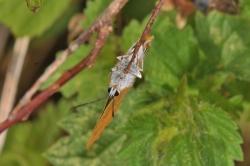 | 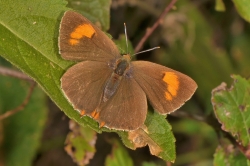 | 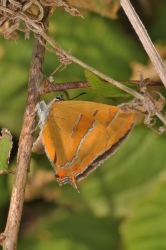 |
| Female upside down on a Blackthorn Twig Photo © Ashley Whitlock | Female Brown Hairstreak Photo © Ashley Whitlock | Female Brown Hairstreak Photo © Ashley Whitlock |
Red Admiral on my knee at 6.30 am.. When I returned from my daily sunrise walk along the Haslar Sea Wall,Gosport,at 6.30am,I walked up my garden path to check my max/min thermometers.After walking through the ivy arch in my north-facing back garden I stopped to read the temperature(7.5 C) and noticed a lovely Red Admiral with open wings perched on my knee.A few days earlier I had an even better view when it landed on my binoculars as I held them close to my face just below my eyes. [Posted by David Tinling]
2013 Butterfly and Moth Report. All members will be pleased to know that the 2013 Butterfly and Moth Report is now available in the members area of the website. Anyone having problems accessing this report can contact Pete Eeles (webmaster) at pete@ukbutterflies.co.uk [Posted by Pete Eeles]
Milton Allotments/Foreshore. I've spent a lovely morning with my granddaughter, and we went out to my local patch to take some photographs as she seems to take an interest in photography so armed away she went. The butterfly count was quite impressive, Holly Blue(4)Comma (1) Painted Lady(1) this had three blood sucking mites on its back it must have been very uncomfortable (this photo was by myself) but the other two were by my granddaughter and I think she may have an eye for a picture especially a common blue in mid-flight!Other species seen were Meadow Brown, Red Admiral, multitudes of Small Whites, and a couple of Green-Veined Whites. [Posted by Ashley Whitlock]
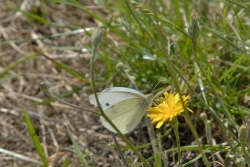 | 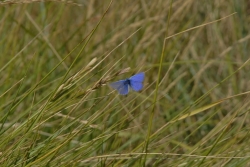 |  |
| Small White (Scarlett Harris) Photo © Ashley Whitlock | Common Blue in flight (Scarlett Harris) Photo © Ashley Whitlock | Painted Lady and Red Mites Photo © Ashley Whitlock |
Grayling at Browndown North. 31 Grayling at Browndown North,Gosport,compared with 67 on 31st July,and only a month before the expected last sighting and entry into the winter half of the year. [Posted by David Tinling]
Common blue at Seafield Park. Four males noted in varying condition in the flowery corners of Seafield Park yesterday afternoon. (I'll never know why these lovely butterflies are referred to as common!!). [Posted by Francis Plowman]
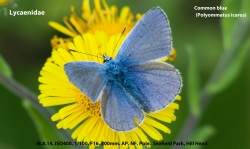 | 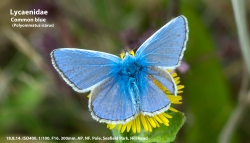 |
| Common blue at Seafield Park Photo © Francis Plowman | Common blue at Seafield Park Photo © Francis Plowman |
Small Coppers. Fresh Small coppers seen and photographed at Seafield Park, Hill Head mid afternoon yesterday. These are the first that I have seen anywhere other than Cyprus this year! [Posted by Francis Plowman]
 | 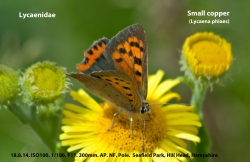 |
| Lycaena phlaes at Seafield Park Photo © Francis Plowman | Lycaena phlaes at Seafield Park Photo © Francis Plowman |
Old Winchester Hill. A brief look around on a cold blustery day with the threat of ever increasing chances of a deluge on the horizon, but thankfully it was brighter in the afternoon session on the down. I managed to see three Silver-Spotted Skippers, but it was really hard work to see any as the wind just caught everything that moved, and they were gone. I think parts of the down now are very overgrown and are not suitable for this specie, although there were sheep grazing on the car-park down. Two male Adonis Blues were also seen and three Clouded Yellows. There are still many Chalkhill Blues, but they have crashed in numbers since I last visited this site. There are very few Small Heaths as well, and the Gatekeeper is now fading fast, few Brown Argus, and good numbers of Common Blues were still on the wing. There were several Hornets patrolling the down, so I suspect they are taking a few invertebrates as they plunder their way over the downland. [Posted by Ashley Whitlock]
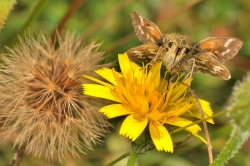 | 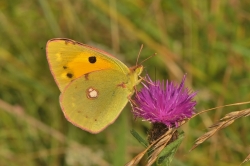 |  |
| Silver-Spotted Skipper Photo © Ashley Whitlock | Clouded Yellow Photo © Ashley Whitlock | Meadow Brown mating Photo © Ashley Whitlock |
Doings on the IOW. Visited the Island on Saturday 16th, primarily to see the breeding Bee-eaters at Wydcombe. Now, this bird is so amazing it needs to be classified as an honorary butterfly and entered for Butterfly of the Year, even if it is insectiverous. It is almost as amazing as the Purple Emperor, almost.
In mid afternoon I visited Brook & Compton downs to look for Clouded Yellows. The turf there is the longest I've seen it, and was rather too long for Clouded Yellows - I saw only one male in 90 mins searching along the lower slopes. 2014 is by far the strongest vegetation growth year I've known (ask any lawnmower). This must impact adversely on our short-turf butterflies.
Chalkhill Blue was abundant - almost uncountable in places - but I saw only about 15 Adonis Blues, all freshly emerged males. The second brood was only just starting, which is normal for mid-August on these downs. No Wall Brown, which was disappointing.
But I did see several full-grown Peacock larvae wandering off to pupate. Now, in mid August when nearly all the 2014-registration Peacocks are already in hibernation, these were either parasitised larvae that were laid as eggs ridiculously late or, as I suspect, second brood larvae.
We could get some interesting second / extra broods this late summer / early autumn, if the weather warms up again. [Posted by Matthew Oates]
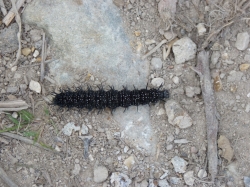 | 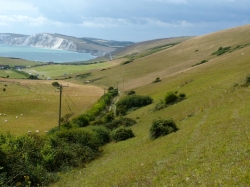 |
| ? 2nd brood Peacock larva Photo © Matthew Oates | Brook & Compton Downs Photo © Matthew Oates |
More brown hairstreaks at Noar hill. 4 brown hairstreaks (females) and 1 clouded yellow were the highlight of my visit to Noar hill [Posted by Nick Lawrence]
 |
| Brown hairstreak Photo © Nick Lawrence |
Sandy Point. Walked the dog around Sandy Point at Hayling this morning while the weather was nice - nice to see three Holly Blues which have been fairly scarce for me this year, also spotted were a few each of Common Blue, Small Copper, Meadow Brown, Gatekeeper, Small White and Red Admiral. [Posted by Mark tutton]
Wall Turns Up At Broughton Down. The weather was rather overcast and cool for my visit to Broughton Down this afternoon and the site is looking decidedly autumnal as the colours of summer fade, perhaps epitomised by a rather forlorn looking Dark Green Fritillary still patrolling the spur of scrubland at the western end of the site. Small butterflies, particularly Chalk Hill Blue and Common Blue are still plentiful in varying states wear and Brown Argus are not difficult to find.
The highlight then was left to a foray down to the very tip of the spur where a pheasant was busy pecking around. What I thought at first glance was another fading Dark Green Fritillary was on wing down there, but when it settled briefly on the hard baked path it revealed its true identity as a male Wall Butterfly. It followed the path for some tens of yards landing and flicking its wings, before disappearing over a hedge. Whilst this is not evidence that Wall are breeding on Broughton Down, they are clearly breeding somewhere close. [Posted by Alan Thornbury]
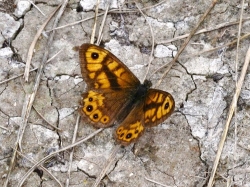 |
| Wall (Male) Photo © Alan Thornbury |
Possible rare sighting of a Small Blue. Although I’m not a member at the moment, I am actively interested in the butterflies in my garden and wanted to report a few sightings and releases.
I live in Keble Road in Chandlers Ford and have a fairly large garden that has a large wild nettle patch and grass areas for butterflies. I have collected caterpillars from these nettles to rear indoors to help boost the wild population of Peacocks and Small Tortoiseshell.
I released 10 Peacock butterflies at the end of June and then found several hatchings of Small Tortoiseshell caterpillars, one of which I took indoors.
To my surprise it turned out to be a huge brood and on the 23rd July we released 81 butterflies and on the 24th July we released 123 butterflies! Only 3 were malformed so a total of 221 viable adults were released. It was quite a sight!
In my garden I have Speckled Woods, Gatekeepers, Holly Blues, Commas, Peacocks, Red Admirals, Small Tortoiseshells, Large and Small Whites, the odd skipper and a large range of moths. These seem to be resident and breed in the garden which is great. I also collect Buddleia so provide a good nectar source which attracts a lot of different bees and passing butterflies and a Hummingbird Hawk moth on the 10th Aug
But the icing on the came when, on the 3rd of August, I was really surprised to see a Small Blue settle on some grass for a few seconds in the garden! I have never seen one here before! It was small, brown with a dusting of blue on the body and base of the wings and a narrow white border. The undersides were a creamy white colour. I am fairly sure that it was a Small Blue because it had no markings on the upper wings at all, just dark chocolate brown with the hint of blue scales. I know we have birds foot trefoil in the garden but I’m not sure about kidney vetch. There are a lot of wild and unusual plants in the garden so it may be possible. It was just a really great thing to finally see one and in my own garden too! I was sceptical at first but after looking at a lot of pictures it my numerous books and on line, I don't think it really could have been anything else. It didn't have the orange markings of a female Common Blue and no hint of black borders and solid blue base of the holly blue. There is a single track railway (Chandlers Ford branch line) and parkland not far from me so it may have come from there.
As is always the way, I just wish I had my camera with me! [Posted by Tracy Piper]
Still Yellow at Chalton Down. Roy Symonds reports that he visited Chalton Down today where the weather was overcast with some long sunny spells, the temperature was 19 degrees. A total of 13 different species were recorded including what seems to be the resident Clouded Yellow. Several second generation Small Heaths where seen along with Brimstone, Large White, Small White, Meadow Brown, Gatekeeper, Speckled Wood, Chalkhill Blue, Common Blue, Brown Argus, Small Tortoiseshell and Small Skipper. [Posted by Richard Symonds]
Old Winchester Hill at its best. It was a blowy, overcast afternoon but thousands of Chalkhill Blues were flying, many scruffy, some newish, with the slope south of the hill fort the best area. Also at least 12 Silver-spotted Skippers looking very neat; at least 5 Clouded Yellows (with one fresh female showing well); a few Marbled Whites and Small Heaths but still plenty of Gatekeepers; and double figures of fresh Brown Argus. No Adonis. The Thymelicus skippers were very scruffy but both Small and Essex were still flying. Double figures of fresh Small Tortoiseshells and one from a previous brood, so knackered that there was hardly a coloured scale left and the edges of both wings were frayed away - a true survivor! [Posted by David Murdoch]
Eastney Migrants. Had a quick look around at Eastney on Thursday lunchtime on the off chance that there might be a few migrants that had made landfall and I wasn't disappointed seeing three Clouded Yellows bombing around. Back up cast included, pleasingly, a few Brown Argus, plenty of Meadow and Hedge Browns, a few Common Blues; Small and Large Whites and a single Red Admiral. [Posted by Mark tutton]
Clouded yellow at Brading. Many butterflies seen this evening at Brading Down.
1 Clouded yellow, many common and chalk hill blues,2 small heaths, many meadow browns. [Posted by Ian Pratt]
Brown Hairstreak at Noar Hill. Female Brown Hairstreak seen today oviposting at Noar Hill along with 3 2nd brood Dukes (including the one with the discoloured wing), 2 Clouded Yellow and a Painted Lady [Posted by Pauline Richards]
 | 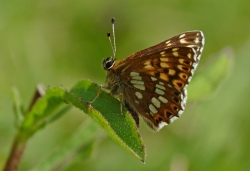 |  |
| Female Brown Hairstreak Photo © Pauline Richards | 2nd brood Duke of Burgundy Photo © Pauline Richards | Female Clouded Yellow Photo © Pauline Richards |
Old Winchester Hill. My last visit to this site for a few weeks, and the Silver-Spotted Skipper is still shy, however there must have been another brood of female Chalkhill Blues emerged, as I saw many females being pestered by up to (10) males, this was taking place all over the car-park down, it looked just like pale blue confetti all over the down. The relentless pursuit of the female of the Chalkhill Blue must have been bizarre to anybody witnessing it and not knowing what was going on. One female Dark-Green Fritillary, was seen, this must be my last of the season...surely? There are still plenty of Small and Essex Skippers and one was seen ovi-positing on some grasses. [Posted by Ashley Whitlock]
Noar Hill (Part 3). On a perfect butterflying day, Noar hill was buzzing with butterflies and other invertebrates. Highlight of the day was another 2nd Generation Duke of Burgundy, and this male had a slight discolouration on the right hind wing. Several Clouded Yellows were seen and the best count of Silver-Washed Fritillaries, I’ve ever seen at Noar Hill and for August for many years I think. I went wandering into the set-aside field margin at the south side of Noar Hill, and here the Brown Argus was flying in very good numbers, along with Silver-Washed, Peacock, and Small Tortoiseshell. The top of the field on the ridge has been left to nature, and here it was literally buzzing. The only downside of this site is the lack of any sign of the Brown Hairstreak. [Posted by Ashley Whitlock]
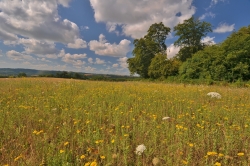 | 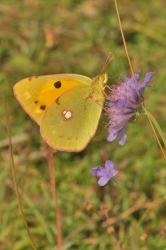 | 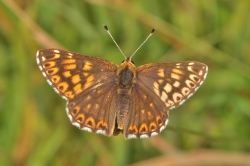 |
| Field Margin next to Noar Hill Photo © Ashley Whitlock | Clouded Yellow and Devils-bit Scabious Photo © Ashley Whitlock | 2nd Generation Duke of Burgundy Photo © Ashley Whitlock |
Annual Butterfly and Moth Report. Just to let you know that the Annual Butterfly and Moth Report is being delivered from the printers tomorrow so should be in the post to BC Branch members at the end of next week. Thank you for being patient. [Posted by Tim Norriss]
Chalton Down Clouded Yellow. Roy Symonds reports that he visited Chalton Down (SU736156), temperature 20.5 degrees, where it seems you will be guaranteed a sighting of at least one Clouded Yellow as was the case today. A single Dark Green Fritillary was flying (as good for this site this year), along with hundreads of Chalkhill Blues. Other species recorded were: Small White, Meadow Brown, Gatekeeper, Comma, Peacock and Small Skipper. [Posted by Richard Symonds]
Noar Hill. Roy Symonds reports visiting Noar Hill where the temperature was 20 degrees. A total of 11 different species were recorded, but alas no sign of the Brown Hairstreak. Marbled Whites were now absent. Species recorded were: Brimstone, Small White, Large White, Meadow Brown, Gatekeeper, Speckled Wood, Small Heath, Common Blue, Brown Argus, Small Tortoiseshell and Peacock. [Posted by Richard Symonds]
Jersey Tiger at Gosport.. Very fresh Jersey Tiger(photographed) basking and flying at 1100 at Gosport & Stokes Bay Golf Course Course near the Club House. [Posted by David Tinling]
Silver-Spotted Skipper late at OWH. Looked for the Silver-Spotted Skipper again at Old Winchester Hill again today but to avail, I’ve always associated this butterfly as a mid-August into September Butterfly, and it looks very much as if it may well turn out that way. I spent an hour on the car-park slope and on the large fort slope as well and all there was where thousands of Chalkhill Blues some getting rather tatty now, but others were in mint condition. There were no Dark Green Fritillaries and Marbled Whites both probably finished now, or any second generation Adonis Blue either. There were a few Brown Argus, many Common Blues, and several Small Tortoiseshells, with an odd Painted Lady. [Posted by Ashley Whitlock]
 | 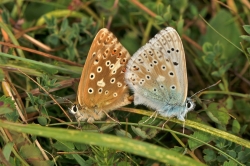 |
| Brown Argus Photo © Ashley Whitlock | Chalkhill Blue Mating Photo © Ashley Whitlock |
Clouded Yellow. I was pleased to see a Clouded Yellow this afternoon as I tidied my front drive in Stubbington. Needless to say it wasn't stopping for a photo! [Posted by Hazel Taylor]
Helice Clouded Yellow. One with 3 Clouded Yellows on Culver Down IOW [Posted by Mark Hallett]
White-letter Hairstreak. Two White-letter Hairstreak today nectaring in the garden at Leckford Abbas (the John Lewis property, SU373374). Also Hummingbird Hawk moth. Pictures here:
http://watcheroftheskies1.blogspot.co.uk/2014/08/leckford-and-area.html [Posted by Andrew Collins]
Noar Hill (Part 2). Visited Noar Hill again today, to glimpse anything representing the Brown Hairstreak, but again out of luck. However two second generation Duke of Burgundies were on the wing, in different parts of the site, which is good news. There were also good numbers of Silver-Washed Fritillaries still on the wing, and the Marbled White was clinging on. Several fresh Brown Argus were espied as well. Other Highlights were Clouded Yellow, Small Heath, and several battered Large Skippers, which have lasted since I saw one on the May 15, so they have a really good innings. Common Blue seems to be the best count on the site at the moment really living up to their name. Purple Emperor have also been seen on the site over the summer, which highlights the fact they do not need great amounts of woodland to survive and breed, breeding probably occurs on Selborne Hill where there is good amounts of Sallow. [Posted by Ashley Whitlock]
 | 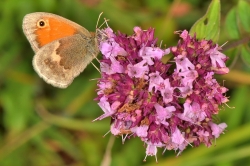 |
| Small Tortoiseshell and Peacock on Hemp Agrimony Photo © Ashley Whitlock | Small Heath Photo © Ashley Whitlock |
A rare double. Having seen the weather forecast today I set my stall to see Brown Hairstreak with two sites in mind - Shipton Bellinger and Noar Hill. I set off for SB at about 9am and immediately encountered a very heavy shower though fortunately it was short lived. On arriving there were already half a dozen people on the western boundary and they had spotted a couple of males high up which I had a brief glimpse of - but I set off to find a quieter area. I soon found a male in reasonable condition on bramble so got a few shots, and during the course of the morning I probably located seven different males in various areas. Also spotted were good numbers of Brimstone and refreshingly Small Tortoiseshell, a pristine Painted Lady and a Clouded Yellow that didn't stop.
After eating my sandwiches I set off across country to Noar Hill where I was not quite as hopeful of meeting my target. On parking in the lane I met Ashley Whitlock who told me about the second brood Duke of Burgundy he had seen so I set off up the track hopeful of seeing a most unlikely double. I headed for one of the pits that is the most popular with Dukes in ‘normal’ season and within minutes I spotted a Duke battling with a Small Skipper and Brown Argus a most unusual sight! I scoured the site hoping to find an elusive BH to complete what would probably be a unique double for one site but despite looking for probably two hours I could neither relocate the Duke nor find a Brown Hairstreak. Altogether a great day seeing 23 different species and both of Hampshires early and late rarities on one day - most peculiar. [Posted by Mark Tutton]
 |  |
| Brown Hairstreak at Shipton Bellinger Photo © Mark Tutton | Second Brood Duke at Noar Hill Photo © Mark Tutton |
Second Brood Dingy Skipper At Noar Hill. My short visit this afternoon to Noar Hill did not provide any sightings of second brood Dukes as I had hoped, but it did produce a second brood Dingy Skipper, seen in the central area of the reserve. It is surprising that this individual is not newly emerged, and has also been around long enough to pick up an unwelcome passenger in the form of a Red Spider Mite, a hint of which can just be seen in the left photo. [Posted by Alan Thornbury]
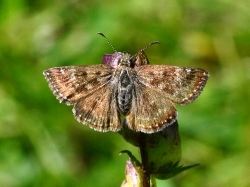 | 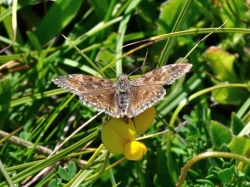 |
| Second Brood Dingy Skipper Photo © Alan Thornbury | Second Brood Dingy Skipper Photo © Alan Thornbury |
Edenbrook Country Park. Todays adventure took me a massive 1 mile from home to the wonderful Edenbrook Country Park on the west side of Fleet (see http://www.naturalengland.org.uk/ourwork/planningdevelopment/edenbrookdevelopmentfeature.aspx.
A mixture of wild seeded meadows,ponds,Willow Beds & Hedges it is a wildlife haven. I was delighted to find good numbers of butterflies in the meadows, the highlight being 8 Clouded Yellow including a female f helice. I have wished for a shot of this butterfly for a long time and in a ten minute chase, falling in ditches, I achieved my aim. Ironic I find it so close to home. I also found Meadow Brown, Gatekeeper,male & female Common Blue, Brown Argus,Red Admiral & Small Tortoiseshell. Not many moths were on view accept the grass moths which were plentiful including the pretty Catoptria pinella. I checked some of the Willow beds and found larval damage so this 15 year project has an exciting future showing how development and conservation can work together. [Posted by Colin Baker]
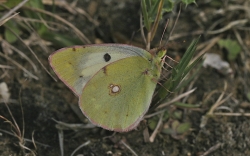 | 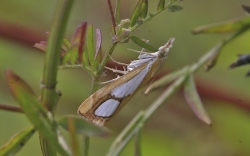 | 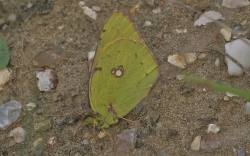 |
| Clouded Yellow f helice Photo © Colin Baker | Catoptria pinella Photo © Colin Baker | Clouded Yellow Male Photo © Colin Baker |
Charlton Down & Idsworth Down Field Trip. On a breezy Lead laden showery day, three souls braved the elements for about 45 minutes only to endure a heavy down pour which just about put an end to any attempt at going on in foul weather. What we did see were a few Chalkhill Blue battling against the wind, several Meadow Browns and Gatekeepers, and an odd Small Heath and several Small Skippers, Six Spotted Burnet Moths and Silver-Y Moth's. Every Saturday on my field trip days seems to be the same, so I thank you those two who braved the elements and came, thankfully not very far for the field trip. [Posted by Ashley Whitlock]
Clouded Yellows at Chalton Down. Roy Symonds reports that he visited Chalton Down (SU736156)which resulted in a brief visit due to a rain shower. He did manage to record two Clouded Yellows which seemed to be still flying after most other species had stopped and also a Dark Green Fritillary. [Posted by Richard Symonds]
Clouded Yellow at Gilkicker,Gosport.. Clouded Yellow at Gilkicker,Gosport,north-west of Fort Gilkicker and the salt marsh. [Posted by David Tinling]